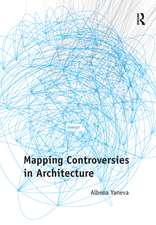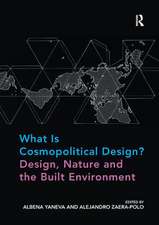Five Ways to Make Architecture Political: An Introduction to the Politics of Design Practice
Autor Albena Yanevaen Limba Engleză Paperback – 30 mai 2018
| Toate formatele și edițiile | Preț | Express |
|---|---|---|
| Paperback (1) | 172.27 lei 6-8 săpt. | |
| Bloomsbury Publishing – 30 mai 2018 | 172.27 lei 6-8 săpt. | |
| Hardback (1) | 539.18 lei 6-8 săpt. | |
| Bloomsbury Publishing – 17 mai 2017 | 539.18 lei 6-8 săpt. |
Preț: 172.27 lei
Preț vechi: 223.94 lei
-23% Nou
Puncte Express: 258
Preț estimativ în valută:
32.96€ • 34.51$ • 27.28£
32.96€ • 34.51$ • 27.28£
Carte tipărită la comandă
Livrare economică 05-19 aprilie
Preluare comenzi: 021 569.72.76
Specificații
ISBN-13: 9781350089716
ISBN-10: 1350089710
Pagini: 200
Ilustrații: 60 bw illus
Dimensiuni: 156 x 234 x 12 mm
Greutate: 0.34 kg
Editura: Bloomsbury Publishing
Colecția Bloomsbury Visual Arts
Locul publicării:London, United Kingdom
ISBN-10: 1350089710
Pagini: 200
Ilustrații: 60 bw illus
Dimensiuni: 156 x 234 x 12 mm
Greutate: 0.34 kg
Editura: Bloomsbury Publishing
Colecția Bloomsbury Visual Arts
Locul publicării:London, United Kingdom
Caracteristici
For students, it functions as both an inspiration and an accessible introduction, while for higher-level scholars it sets out a new framework for further enquiry
Notă biografică
Albena Yaneva is Professor in Architectural Theory at the University of Manchester, UK, Director of the Manchester Architecture Research Centre, UK and Visiting Professor at the Princeton School of Architecture, USA. She is the author of Mapping Controversies in Architecture (2012), The Making of a Building: A Pragmatist Approach to Architecture (2009), and Made by the Office for Metropolitan Design: An Ethnography of Design (2009).
Cuprins
Introduction1. Architecture and Politics 2. How to Study Ecology of Practice?3. Political Objects (The first way of becoming political)4. Experiments in Practice (The second way of becoming political) 5. The Multiple Natures of a City (The third way of becoming political) 6. Sites of Politics (The fourth way of becoming political) 7. Urban Publics (The fifth way of becoming political) Conclusion Bibliography
Recenzii
Five Ways to Make Architecture Political is a careful, engaging, and timely work. The title belies its most superb contribution, which is the development (and deployment) of a methodology, a practice, by which architecture might be engaged.
How is architecture political? What is the agency of buildings? Because of contemporary social, political and environmental challenges, these questions have become crucial. Using Actor-Network Theory in an innovative way, Albena Yaneva disrupts received answers by giving priority to what buildings really do, instead of focusing on what they are supposed to mean to their designers, owners or users.
Albena Yaneva's wonderful book asks us, above all, to take the study of architecture's politics slowly. Rather than jump to easy and ready-made political conclusions, she shows us both how it is possible and why it is necessary to take time to describe the politics of architecture in process, weaving theory and fieldwork together into a compelling synthesis. Five Ways to Make Architecture Political is a vital intervention, for students, practitioners and theorists alike.
How is architecture political? What is the agency of buildings? Because of contemporary social, political and environmental challenges, these questions have become crucial. Using Actor-Network Theory in an innovative way, Albena Yaneva disrupts received answers by giving priority to what buildings really do, instead of focusing on what they are supposed to mean to their designers, owners or users.
Albena Yaneva's wonderful book asks us, above all, to take the study of architecture's politics slowly. Rather than jump to easy and ready-made political conclusions, she shows us both how it is possible and why it is necessary to take time to describe the politics of architecture in process, weaving theory and fieldwork together into a compelling synthesis. Five Ways to Make Architecture Political is a vital intervention, for students, practitioners and theorists alike.












